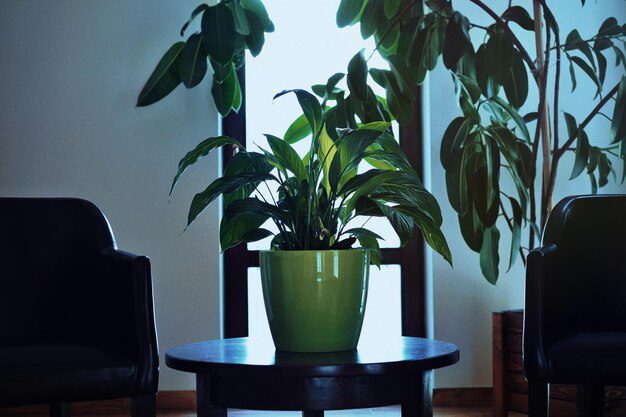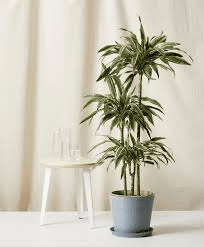
Creating an indoor green oasis is possible, even if your space lacks sunlight. Tall, low-light indoor plants add height, texture, and a touch of nature to dimly lit rooms. These plants thrive in low-light conditions, making them ideal for apartments, offices, or any space lacking natural light.
Here’s a detailed guide to seven tall indoor plants that require minimal light and are easy to maintain.
- 1. Snake Plant (Dracaena spp.)
- 2. ZZ Plant (Zamioculcas zamiifolia)
- 3. Parlor Palm (Chamaedorea elegans)
- 4. Corn Plant (Dracaena fragrans)
- 5. Rubber Plant (Ficus elastica)
- 6. Dragon Tree (Dracaena spp.)
- 7. Cast Iron Plant (Aspidistra elatior)
- Benefits of Tall, Low-Light Plants
- Placement Ideas for Low-Light Tall Plants
- Final Tips for Success
- Conclusion
1. Snake Plant (Dracaena spp.)
The Snake Plant, also known as Mother-in-Law’s Tongue, is one of the most resilient houseplants. Its upright, sword-like leaves make it a fantastic choice for adding height to any room. Snake Plants can grow up to 3 feet tall indoors and adapt well to various lighting conditions, including low light.
Care Tips:
- Light: Thrives in full shade to bright, indirect light.
- Watering: Allow the soil to dry out completely before watering. Typically, every 2-3 weeks works well.
- Special Feature: Known for purifying the air, it’s a great addition to bedrooms and living spaces.
Bonus Tip:
If you have pets, keep the Snake Plant out of their reach, as it’s toxic to cats and dogs if ingested.
2. ZZ Plant (Zamioculcas zamiifolia)
The ZZ Plant is a low-maintenance gem with glossy, deep green leaves. It’s a slow grower but can eventually reach heights up to 3-4 feet, making it a tall and striking option for low-light areas. It’s also drought-tolerant, so it won’t matter if you forget to water it occasionally.
Care Tips:
- Light: Performs well in full shade to bright, indirect light.
- Watering: Water only when the soil is completely dry.
- Special Feature: Its ability to thrive in almost any condition makes it a favorite for busy or forgetful plant owners.
Bonus Tip:
ZZ Plants are toxic to humans and pets, so handle with care and keep them out of reach.
3. Parlor Palm (Chamaedorea elegans)
The Parlor Palm is a classic indoor plant that exudes elegance. It’s a slow-growing palm that can reach heights of up to 4-6 feet over time, making it perfect for adding vertical interest. Its feathery fronds bring a tropical vibe to any low-light corner.
Care Tips:
- Light: Does best in partial to moderate shade.
- Watering: Water when the top inch of soil feels dry.
- Special Feature: Non-toxic to pets, making it a safer option for households with furry friends.
Bonus Tip:
Consider misting the leaves occasionally to maintain humidity and prevent browning tips.
4. Corn Plant (Dracaena fragrans)
The Corn Plant is another excellent choice for low-light spaces. Its tall, slender trunk and arching green leaves with yellow stripes make it a visually appealing addition to any room. Indoors, it can grow up to 6 feet tall with proper care.
Care Tips:
- Light: Prefers light shade but can tolerate low-light areas.
- Watering: Let the soil dry out completely before watering.
- Special Feature: Its air-purifying qualities make it a great option for improving indoor air quality.
Bonus Tip:
Rotate the pot occasionally to ensure even growth, as Corn Plants may lean toward light sources.
5. Rubber Plant (Ficus elastica)
The Rubber Plant is known for its shiny, broad leaves and ability to grow tall indoors. With proper care, it can reach heights of up to 8 feet, making it a standout feature in low-light areas. While it prefers some light, it can survive in dimmer conditions.
Care Tips:
- Light: Light shade to bright, indirect light is best.
- Watering: Allow the top 2 inches of soil to dry before watering.
- Special Feature: Its robust, tree-like appearance adds structure to any room.
Bonus Tip:
Use a damp cloth to wipe the leaves occasionally. This keeps them shiny and dust-free, allowing better photosynthesis.
6. Dragon Tree (Dracaena spp.)
The Dragon Tree is a hardy plant that thrives in a variety of lighting conditions. Its thin, arching leaves and tall, slim trunk make it a space-saving option for adding height to low-light corners. Dragon Trees can grow up to 3 feet tall indoors.
Care Tips:
- Light: Tolerates semi-shade or indirect light.
- Watering: Water when the top inch of soil feels dry.
- Special Feature: Its striking foliage and low maintenance needs make it a popular choice for offices and homes.
Bonus Tip:
Dragon Trees are mildly toxic to pets, so place them out of reach to avoid accidental ingestion.
7. Cast Iron Plant (Aspidistra elatior)

The Cast Iron Plant is virtually indestructible, living up to its name. This plant is perfect for people who might neglect their green companions occasionally. It grows up to 2-3 feet tall indoors and thrives in dimly lit spaces.
Care Tips:
- Light: Can handle full shade or bright, indirect light.
- Watering: Let the soil dry completely before watering.
- Special Feature: Non-toxic to pets, making it a safe addition to homes with animals.
Bonus Tip:
Dust the leaves occasionally to keep the plant looking its best and promote healthy growth.
Benefits of Tall, Low-Light Plants
Incorporating these plants into your home comes with several benefits beyond aesthetics:
- Air Purification: Many of these plants, such as the Snake Plant and Corn Plant, help filter toxins from the air, promoting a healthier indoor environment.
- Space Optimization: Tall plants draw the eye upward, creating an illusion of higher ceilings and adding depth to your space.
- Stress Relief: Studies show that being around greenery can reduce stress and improve overall well-being.
- Low Maintenance: These plants thrive in minimal light and require infrequent watering, making them perfect for busy lifestyles.
Placement Ideas for Low-Light Tall Plants
- Corners: Place tall plants in corners to make use of underutilized space while softening sharp angles in the room.
- Beside Furniture: Use plants like the Rubber Plant or Dragon Tree as natural dividers or accents next to sofas or desks.
- Near Windows: While they thrive in low light, placing them near windows with filtered light can encourage better growth.
- Bathrooms: Plants like the Cast Iron Plant and Parlor Palm enjoy the humidity of bathrooms, even with low light.
Final Tips for Success
- Don’t Overwater: Overwatering is one of the most common mistakes with low-light plants. Allow the soil to dry out between waterings to prevent root rot.
- Rotate Regularly: Rotate your plants occasionally to ensure even growth and prevent them from leaning toward light sources.
- Use Grow Lights: If your space is extremely dim, consider supplementing with grow lights to keep your plants thriving.
- Maintain Humidity: Many of these plants appreciate a humid environment. Use a pebble tray or mist the leaves occasionally.
Conclusion
Tall, low-light indoor plants can transform your space into a lush, green retreat without demanding much attention. From the hardy Snake Plant to the elegant Parlor Palm, there’s a plant for every style and need. With minimal effort, these plants will thrive in even the dimmest corners, adding beauty, freshness, and a touch of nature to your home.



